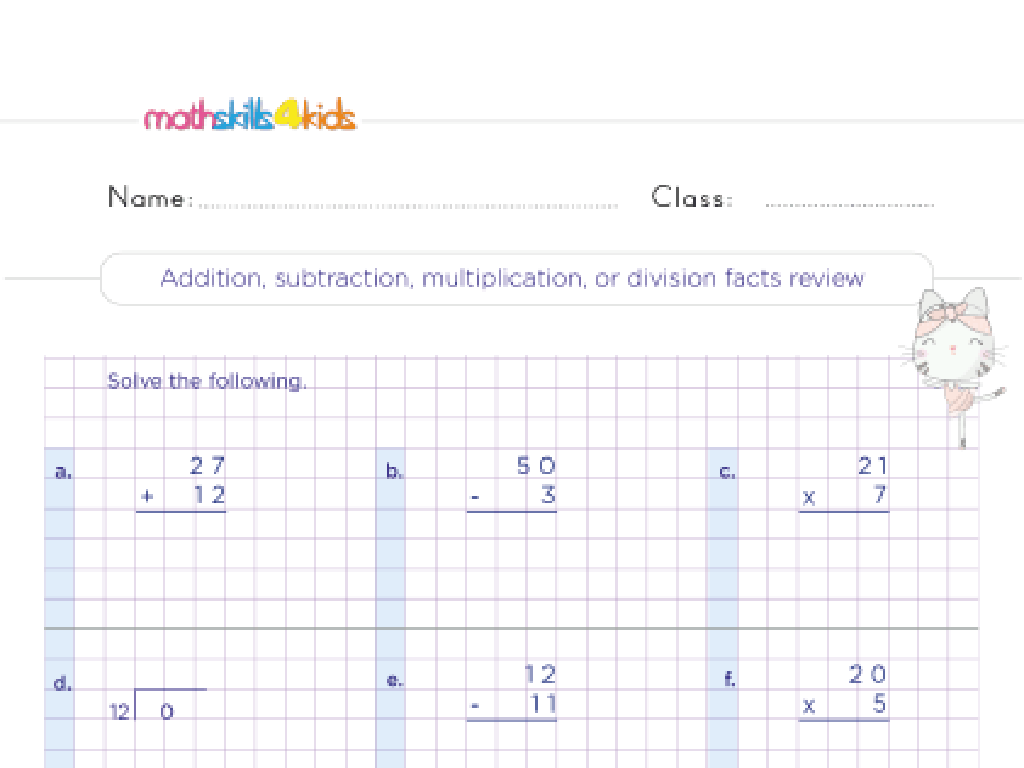Multiply Powers: Integer Bases
Subject: Math
Grade: Eighth grade
Topic: Exponents
Please LOG IN to download the presentation. Access is available to registered users only.
View More Content
Introduction to Exponents
– Recap: What are exponents?
– Exponents represent repeated multiplication
– Base vs. Exponent concept
– Base: number being multiplied; Exponent: how many times
– Exponential growth in real life
– Populations, finances, and nuclear reactions
– Importance of mastering exponents
|
Begin with a brief review of exponents, emphasizing their role in representing repeated multiplication, which simplifies expressions and calculations. Clarify the difference between the base (the number being multiplied) and the exponent (indicating how many times the base is used as a factor). Provide real-world examples of exponential growth, such as population growth, compound interest in finances, and chain reactions in nuclear physics, to illustrate the concept’s relevance. Highlight the importance of understanding exponents as a foundational skill in mathematics, which will be applied in various higher-level math concepts and real-life situations. Encourage students to think of additional examples where exponents might apply.
Multiplying Powers with the Same Base
– Rule for multiplying powers
– When bases are identical, exponents are added
– Example: 2^3 * 2^4
– 2^3 * 2^4 demonstrates this rule
– Add exponents with same base
– Adding exponents is only valid for like bases
– Simplify to 2^(3+4)
– Resulting in 2^7, which equals 128
|
This slide introduces the fundamental rule for multiplying powers with the same base, which is to add the exponents. It’s crucial for students to understand that this rule only applies when the bases are the same. The example provided, 2^3 * 2^4, is a straightforward illustration of this rule. Students should be encouraged to practice this concept with various bases and exponents to solidify their understanding. Emphasize that this is a shortcut for writing out and multiplying the long form, such as 2*2*2 times 2*2*2*2, and it simplifies the process of multiplication of powers.
Exponent Multiplication Practice
– Solve 3^2 * 3^5
3^2 * 3^5 = 3^(2+5) = 3^7
– Classwork: Simplify 4^3 * 4^2
4^3 * 4^2 = 4^(3+2) = 4^5
– Discuss order of operations
PEMDAS: Parentheses, Exponents, Multiplication/Division, Addition/Subtraction
– Why order matters in exponents
Correct order ensures accurate results
|
This slide is focused on practicing the multiplication of powers with the same base. Start by solving 3^2 * 3^5 together, reinforcing the rule that when multiplying powers with the same base, you add the exponents. Move on to classwork where students simplify 4^3 * 4^2. Emphasize the importance of the order of operations, especially when dealing with exponents, to avoid mistakes in calculations. Explain that following the correct order is crucial for achieving accurate results. Provide additional examples if time allows and encourage students to solve them independently, then discuss as a class.
Visualizing Multiplication of Powers
– Visualize exponent rules on grids
– Use grids to show 2^2 as a 2×2 square, then 2^3 as 2x2x2 cube
– Interactive student participation example
– Students volunteer to solve 3^2 * 3^3 on the board
– Multiply powers with same base
– When bases are same, add exponents: 3^2 * 3^3 = 3^(2+3)
– Apply rules to simplify expressions
– Simplify 4^3 * 4^2 to 4^5 using exponent rules
|
This slide aims to help students visualize the process of multiplying powers with the same integer base using number lines or grids. By representing exponents as dimensions on a grid, students can see how multiplying powers is equivalent to adding the exponents. An interactive example will involve student participation to solve a multiplication of powers problem on the board, reinforcing the concept. The teacher should guide the students through the process, ensuring they understand that the bases must be the same to apply the rule of adding exponents. The activity will conclude with students applying the rules to simplify expressions with powers.
Multiplying Powers with Integer Bases
– Multiplying with negative bases
– When bases are negative, consider the number of negative factors to determine the sign of the answer.
– Understanding zero as a base
– Zero raised to any positive exponent is always zero. But zero to the power of zero is undefined.
– Classwork: Multiply powers of -2
– Calculate (-2)^3 * (-2)^4 and determine the sign and value of the result.
– Strategies for solving problems
|
This slide introduces students to the complexities of multiplying powers with integer bases, especially when dealing with negative bases and zero. Start by explaining that the sign of the result depends on the number of negative factors: an even number of negative factors will result in a positive product, while an odd number will result in a negative product. Emphasize that any nonzero number to the power of zero is 1, and zero to any positive power is 0. For the classwork, guide students through the process of multiplying (-2)^3 * (-2)^4, reinforcing the rules for multiplying exponents with the same base. Encourage students to discuss their strategies and understanding of the concepts as they work through the problem.
Class Activity: Multiplying Powers with Integer Bases
– Divide into small groups
– Each group gets unique power sets
– Multiply the powers together
– Use the rule: When multiplying powers with the same base, add the exponents
– Present solutions and methods
– Explain the steps taken to reach the answer
|
This activity is designed to promote collaborative learning and reinforce the concept of multiplying powers with integer bases. Divide the class into small groups, ensuring a mix of abilities in each group. Provide each group with a different set of powers to multiply, such as (2^3) * (2^4), (3^2) * (3^5), etc. Encourage students to apply the rule of adding exponents when the bases are the same. After completing the multiplication, each group will present their solutions to the class, explaining the process they used. This will help students articulate their understanding and learn from each other. Possible variations for different groups could include multiplying more than two powers, using negative exponents, or introducing powers with variables as bases.
Homework and Lesson Summary: Exponents
– Review: Multiplying Powers with Same Base
– When multiplying powers with the same base, add the exponents.
– Homework: Practice Problem Set
– Solve assigned problems to reinforce understanding of multiplying powers.
– Create Your Own Examples
– Encourage creativity by inventing unique problems involving exponents.
– Key Takeaways of Today’s Lesson
|
As we wrap up today’s lesson on multiplying powers with integer bases, ensure students understand the main rule: when multiplying powers with the same base, we add the exponents. For homework, assign a set of problems that cover a range of difficulties to solidify this concept. Encourage students to create their own examples, which helps deepen their understanding and allows them to apply the concept in different contexts. Summarize the lesson by highlighting the importance of this rule in simplifying expressions and solving more complex algebraic problems. This will prepare them for future topics in algebra and beyond.






